概述
ALEC的概念我们已经说过啦,需要了解的同学请点击这里。在旅行出发之前我们来看看这次旅行的生活用品,看看这个算法中的主要成员变量。注意不要死记,结合我们在概念中讲的原理理解记忆。完整代码点击这里,建议先看概念抓住逻辑框架,再一遍代码注释形成初步理解,再看此文会理解更深。
成员变量
public class Alec {
/**
* 整个数据集
*/
Instances dataset;
/**
* 可以提供的最大查询数。
*/
int maxNumQuery;
/**
* 查询的实际数量。
*/
int numQuery;
/**
* 半径, 也是论文的dc. 它用于密度计算。
*/
double radius;
/**
* 实例的密度, 论文中的rho.
*/
double[] densities;
/**
* 到老大之间的距离
*/
double[] distanceToMaster;
/**
* 给索引排序, 其中第一个元素表示密度最大的实例。
*
*/
int[] descendantDensities;
/**
* 优先级
*/
double[] priority;
/**
* 任意两点之间的最大距离。
*/
double maximalDistance;
/**
* 上级,大哥
*/
int[] masters;
/**
* 预测标签
*/
int[] predictedLabels;
/**
* 实例状态。0表示未处理,1表示已查询,2表示已分类。
*/
int[] instanceStatusArray;
/**
* 子代索引以子代顺序显示实例的代表性。
*
*/
int[] descendantRepresentatives;
/**
* 指出每个实例的集群. 它仅被用于clusterInTwo(int[]);
*/
int[] clusterIndices;
/**
* 大小不超过此阈值的块不应进一步拆分。
*/
int smallBlockThreshold = 3;
主函数(程序入口)
各位旅客同志们请拿好自己的行李,请到检票口进行检票,我们即将发车。
public static void main(String[] args) {
long tempStart = System.currentTimeMillis();
System.out.println("Starting ALEC.");
String arffFilename = "D:/data/iris.arff";
// String arffFilename = "D:/data/mushroom.arff";
Alec tempAlec = new Alec(arffFilename);
// The settings for iris
tempAlec.clusterBasedActiveLearning(0.15, 30, 3);
// The settings for mushroom
// tempAlec.clusterBasedActiveLearning(0.1, 800, 3);
System.out.println(tempAlec);
long tempEnd = System.currentTimeMillis();
System.out.println("Runtime: " + (tempEnd - tempStart) + "ms.");
}// Of main
System.currentTimeMillis(),计算一段代码执行的时间,可以通过该方法获取到起始时间,结束时间,然后计算时间差,最后再进行时间单位的转换。也就是用来记录我们这班车要做多长时间。随后便是导入数据集,走,进去看看。
文件读取
public Alec(String paraFilename) {
try {
FileReader tempReader = new FileReader(paraFilename);
dataset = new Instances(tempReader);
dataset.setClassIndex(dataset.numAttributes() - 1);
tempReader.close();
} catch (Exception ee) {
System.out.println(ee);
System.exit(0);
} // Of fry
computeMaximalDistance();
clusterIndices = new int[dataset.numInstances()];// 空间变成了数据集的大小
}// Of the constructor
很多部分是一样的,但是看看这两句话。
computeMaximalDistance();
clusterIndices = new int[dataset.numInstances()];// 空间变成了数据集的大小
computeMaximalDistance()
public void computeMaximalDistance() {
maximalDistance = 0;
double tempDistance;
for (int i = 0; i < dataset.numInstances(); i++) {
// 对每一个变量进行循环,找出最大值
for (int j = 0; j < dataset.numInstances(); j++) {
tempDistance = distance(i, j);// 计算两点直接的距离
if (maximalDistance < tempDistance) {
maximalDistance = tempDistance;
} // Of if
} // Of for j
} // Of for i
System.out.println("maximalDistance = " + maximalDistance);
}// Of computeMaximalDistance
这里就是计算出这个数据集两个样本的之间最大的距离,计算完之后我们就打印出来,他有什么用呢?
clusterBasedActiveLearning(double paraRatio, int paraMaxNumQuer)
public void clusterBasedActiveLearning(double paraRatio, int paraMaxNumQuery,
int paraSmallBlockThreshold) {
radius = maximalDistance * paraRatio; // 原来这个比例就是乘以最大的距离 表示 dc
smallBlockThreshold = paraSmallBlockThreshold; // 一个块中的最小样本点个数
maxNumQuery = paraMaxNumQuery; // 查询的最大个数
predictedLabels = new int[dataset.numInstances()]; // 标签预测数组
for (int i = 0; i < dataset.numInstances(); i++) {
predictedLabels[i] = -1; // 对其进行初始化。
} // Of for i
computeDensitiesGaussian(); // 密度计算
computeDistanceToMaster(); // 到大哥之间的距离
computePriority(); // 优先级
descendantRepresentatives = mergeSortToIndices(priority); // 对优先级排序,是一个降序
System.out.println(
"descendantRepresentatives = " + Arrays.toString(descendantRepresentatives));
numQuery = 0;
clusterBasedActiveLearning(descendantRepresentatives);
}// Of clusterBasedActiveLearning
这个方法有重载,我们先介绍第一个。这里传过来三个参数,比例,最大查询的标签数目,以及我们分块时最小的限度。来回答刚刚提出的问题,maximalDistance 的作用便是乘以这个比例 ratio 来获得我们半径。经过一轮初始化,预测标签数组值为 -1 。物以类聚人以群分,我们现在就去看看怎么去找属于我们那一类的大哥。
computeDensitiesGaussian() 方法
public void computeDensitiesGaussian() {
System.out.println("radius = " + radius);
densities = new double[dataset.numInstances()];// 实例的密度数组它的大小是实例数目
double tempDistance;
for (int i = 0; i < dataset.numInstances(); i++) {
for (int j = 0; j < dataset.numInstances(); j++) {
tempDistance = distance(i, j);// 计算出两点之间的距离
densities[i] += Math.exp(-tempDistance * tempDistance / radius / radius);
} // Of for j
} // Of for i
System.out.println("The densities are " + Arrays.toString(densities) + "\r\n");
}// Of computeDensitiesGaussian
这个高斯密度就不得了,我们之前的 knn,k-Means 是通过距离的,高斯密度就把距离和样本数进行综合考虑。 d e n s i t y = ∑ j = 1 n e − ( d 2 r 2 ) density=\sum_{j=1}^ne^{-(\frac{d^2}{r^2})} density=j=1∑ne−(r2d2)
什么意思,我们要计算以这个点为中心,半径 r 内的密度。我们就去对所有样本进行计算距离,然后再来看贡献度,你距离越大我们的 density 越小,贡献度越低,当距离接近 0 的时候,贡献度就是1,把所有的点贡献度加起来就得到了密度。你问我那么这个点的孩子有多少个呢?我的回答是,不知道,至少这个方法看不出来,我们只知道某点的密度最大。
computeDistanceToMaster() 找大哥
public void computeDistanceToMaster() {
distanceToMaster = new double[dataset.numInstances()]; // 到大哥之间的距离
masters = new int[dataset.numInstances()]; // 大哥数组
descendantDensities = new int[dataset.numInstances()]; // 降序排列的密度
instanceStatusArray = new int[dataset.numInstances()]; // 状态数组
descendantDensities = mergeSortToIndices(densities); // 对密度进行降序排列,然后返回索引
distanceToMaster[descendantDensities[0]] = maximalDistance; // 密度最大的点没有大哥,他就是爷(根节点)
double tempDistance;
for (int i = 1; i < dataset.numInstances(); i++) {
// 从第二高的密度点去寻找自己的老大
// 初始化
distanceToMaster[descendantDensities[i]] = maximalDistance; // 初始化,和大哥的距离设置为最远
for (int j = 0; j <= i - 1; j++) {
// 我们找大哥,一定要找密度比自己大的点,不然凭什么做我的大哥呢?
tempDistance = distance(descendantDensities[i], descendantDensities[j]); // 计算距离
if (distanceToMaster[descendantDensities[i]] > tempDistance) {
distanceToMaster[descendantDensities[i]] = tempDistance;
masters[descendantDensities[i]] = descendantDensities[j]; // 选择最近的距离作为我的大哥。
} // Of if
} // Of for j
} // Of for i
System.out.println("First compute, masters = " + Arrays.toString(masters));
System.out.println("descendantDensities = " + Arrays.toString(descendantDensities));
}// Of computeDistanceToMaster
每句话的分析已经列上,我们找大哥是由要求的:第一你的密度要比我的大,第二距离还要最近,远亲不如近邻嘛。
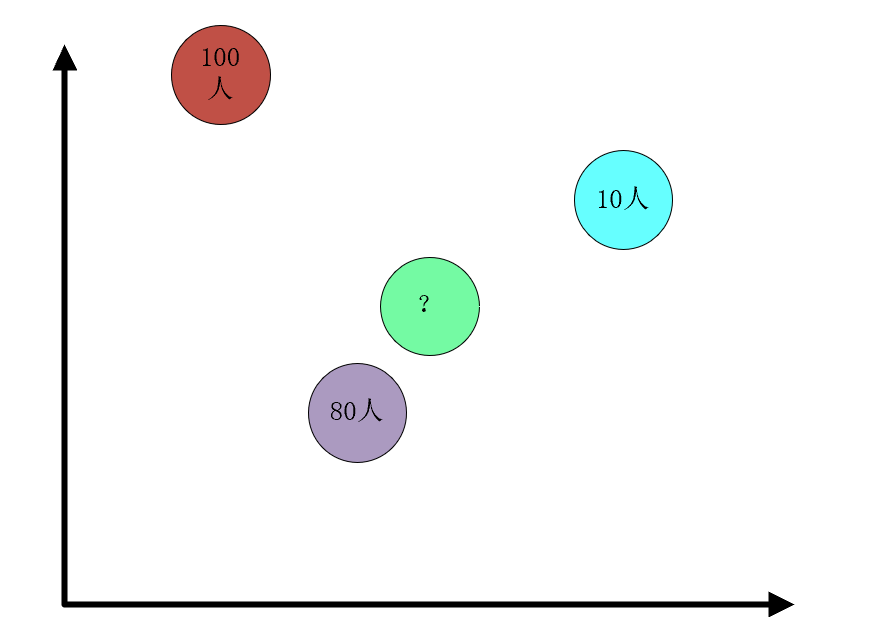
绿球找谁做大哥?100人的褐色球太远,起冲突了等你人过来黄花菜都凉了,10太少了,综合考虑人数距离我们选择和紫色球搞好关系,认他做大哥。接下来我们要做的便是给大哥排序,返回大哥的住址,而不是密度大小哦!这里有一点绕,我们才一点刹车慢慢来看。
mergeSortToIndices(densities) 给大哥排序
public static int[] mergeSortToIndices(double[] paraArray) {
int tempLength = paraArray.length;
int[][] resultMatrix = new int[2][tempLength];// 用于归并排序,两个数组来回跳跃。
// 初始化
int tempIndex = 0;
for (int i = 0; i < tempLength; i++) {
resultMatrix[tempIndex][i] = i;
} // Of for i
// 归并
int tempCurrentLength = 1;
// 当前合并组的索引。
int tempFirstStart, tempSecondStart, tempSecondEnd;
while (tempCurrentLength < tempLength) {
// 分成两组
// 这里的边界自适应于不等于2^k的数组长度。math.ceil(x)返回大于等于参数x的最小整数,即对浮点数向上取整.
for (int i = 0; i < Math.ceil((tempLength + 0.0) / tempCurrentLength / 2); i++) {
// 块的界限
tempFirstStart = i * tempCurrentLength * 2;
tempSecondStart = tempFirstStart + tempCurrentLength;
tempSecondEnd = tempSecondStart + tempCurrentLength - 1;
if (tempSecondEnd >= tempLength) {
tempSecondEnd = tempLength - 1;
} // Of if
// 对这个组进行归并
int tempFirstIndex = tempFirstStart;
int tempSecondIndex = tempSecondStart;
int tempCurrentIndex = tempFirstStart;
if (tempSecondStart >= tempLength) {
for (int j = tempFirstIndex; j < tempLength; j++) {
resultMatrix[(tempIndex + 1) % 2][tempCurrentIndex] = resultMatrix[tempIndex
% 2][j];
tempFirstIndex++;
tempCurrentIndex++;
} // Of for j
break;
} // Of if
while ((tempFirstIndex <= tempSecondStart - 1)
&& (tempSecondIndex <= tempSecondEnd)) {
if (paraArray[resultMatrix[tempIndex
% 2][tempFirstIndex]] >= paraArray[resultMatrix[tempIndex
% 2][tempSecondIndex]]) {
resultMatrix[(tempIndex + 1) % 2][tempCurrentIndex] = resultMatrix[tempIndex
% 2][tempFirstIndex];
tempFirstIndex++;
} else {
resultMatrix[(tempIndex + 1) % 2][tempCurrentIndex] = resultMatrix[tempIndex
% 2][tempSecondIndex];
tempSecondIndex++;
} // Of if
tempCurrentIndex++;
} // Of while
// 剩余部分。
for (int j = tempFirstIndex; j < tempSecondStart; j++) {
resultMatrix[(tempIndex + 1) % 2][tempCurrentIndex] = resultMatrix[tempIndex
% 2][j];
tempCurrentIndex++;
} // Of for j
for (int j = tempSecondIndex; j <= tempSecondEnd; j++) {
resultMatrix[(tempIndex + 1) % 2][tempCurrentIndex] = resultMatrix[tempIndex
% 2][j];
tempCurrentIndex++;
} // Of for j
} // Of for i
tempCurrentLength *= 2;
tempIndex++;
} // Of while
return resultMatrix[tempIndex % 2];
}// Of mergeSortToIndices
这个地方是一个难点,我们将细致一点。首先程序运行到第一个 while 我们对一些变量初始化如图:
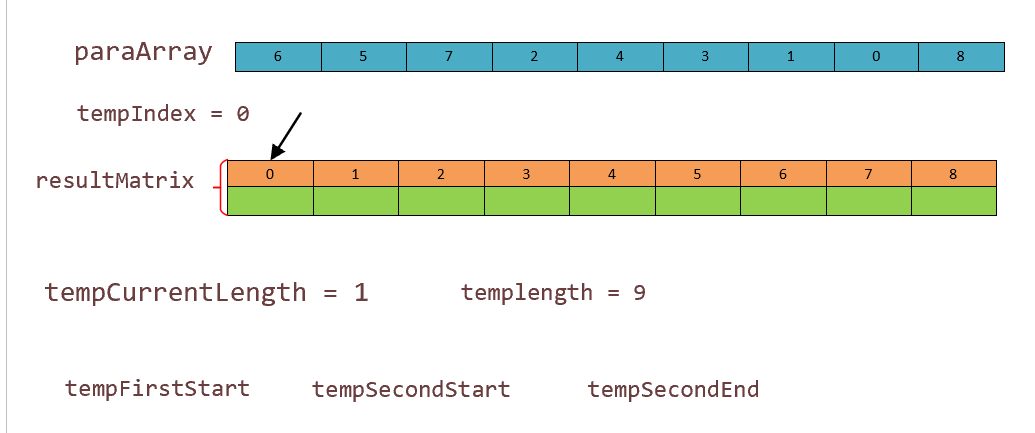
之后我们遍进入第一个 while 进行 for 循环分块,第一次,终止条件 i = 5. 按照程序初始话 tempFirstStart,tempSecondStart,tempSecondEnd 赋值如图:

if (tempSecondStart >= tempLength)
因为 1 < 9,所以我们这里的不会执行里面的 for 循环 ,直接转入第二 while 。第二个 while 就是进行比较,在这里我们先来看一看比较的原理:

我们比较是两个子块的大小,tempFirstStart,tempSecondStart,tempSecondEnd 用来卡主两个块的位置,即开始点和结束比较点。而tempIndex 和 tempSecondIndex 在这两个块中移动,用他们两个所指向的元素比较大小,排序。我们第二 while 循环范围便是前面两个元素进行比较。如图:
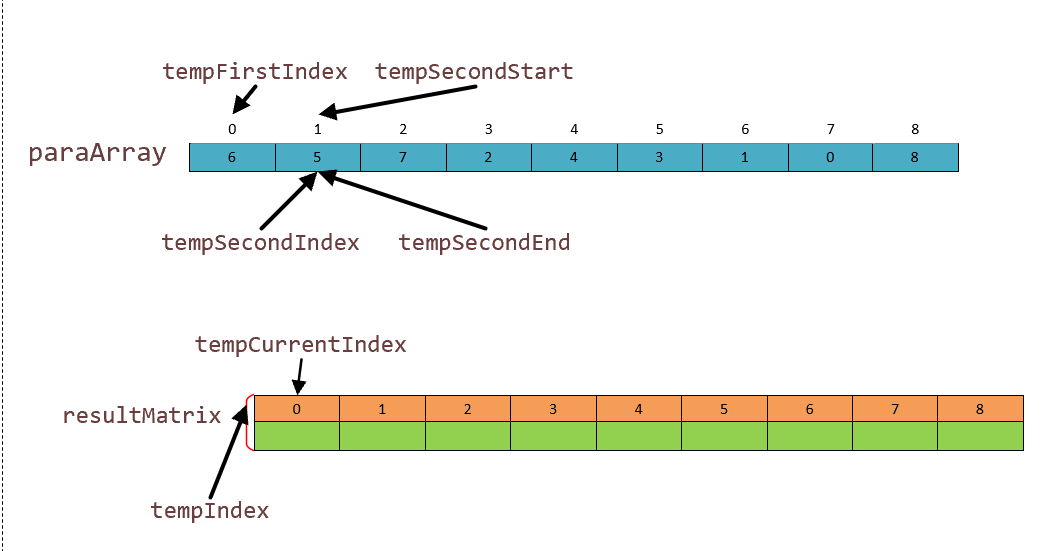
我们把 paraArray 里面前两个数进行比较,发现 6 > 5,然后我们把对应的索引进行交换放在第绿色的那一列。

我们进行第二轮:两两比较,该比较 2 和 3 位置的元素。这里我可以解释一下:tempCurrentLength 就是控制两个块的大小,tempCurrentIndex 负责我们索引数组的移动。 ,我们这里是1,所以tempFirst哪些卡位指针集体往右移动去寻找未排序的范围,这里从 [0] [1] 跑到了 [2] [3].如图:
 在这里跳过一次,来看看最后剩一个 8 怎么处理 ?再来看看代码
在这里跳过一次,来看看最后剩一个 8 怎么处理 ?再来看看代码
tempSecondStart = tempFirstStart + tempCurrentLength; // 从第一块的第一个开始,+ 长度就会到达第二个开始点
tempSecondEnd = tempSecondStart + tempCurrentLength - 1; // 记录第二块结束位置,第二块开始+长度-1
if (tempSecondEnd >= tempLength) {
// 如果第二次end 长度超过了数组的长度,下面一句进行回退。
tempSecondEnd = tempLength - 1;
} // Of if
// 对这个组进行归并,把开始的两个引用,复制给两次开始的索引,tempcurrentIndex也是第一次开始的引用
int tempFirstIndex = tempFirstStart;
int tempSecondIndex = tempSecondStart;
int tempCurrentIndex = tempFirstStart;
if (tempSecondStart >= tempLength) {
// 如果第二部分开始的引用大于块长度
for (int j = tempFirstIndex; j < tempLength; j++) {
// 就从第一个块开始,遍历
resultMatrix[(tempIndex + 1) % 2][tempCurrentIndex] = resultMatrix[tempIndex
% 2][j]; // 把数组填满。
tempFirstIndex++;
tempCurrentIndex++;
} // Of for j
break;
} // Of if
最后一个指针是这样子的

注意看啊,tempSecondStart 和 tempSecondEnd tempSecondIndex 指向 9 越界了,然后我们用一个 if 语句来判断,越界?那我就把 tempSecondEnd 拉回 8 的位置,然后进行赋值。但是,我们要注意,tempSecondIndex 的值来自于tempSecondStart,所以是 9 。也就是说我们第二个块开始就不存在,为空了。然后我们再来一个 if 对第二个块为空的情况处理,便是把块1的值赋值到索引数组中去。
tempCurrentLength *= 2;
tempIndex++;
长度翻倍,现在我们就把索引第一个位置作为结果储存去了。状况如图:

现在我们再来比较,当块的长度是2时,第一轮比较:0 号位和 2 号位比较,6 < 7,7号元素进入resultMatrix数组[0] [0],tempCuurentIndex控制着结果存放位置,指针后移一个。第二块的遍历指针 tempSecondIndex 后移一位与 6 比较,发现 6 大,那么 0 号索引进入索引数组 resultMatrix [0][1]结果如下图:
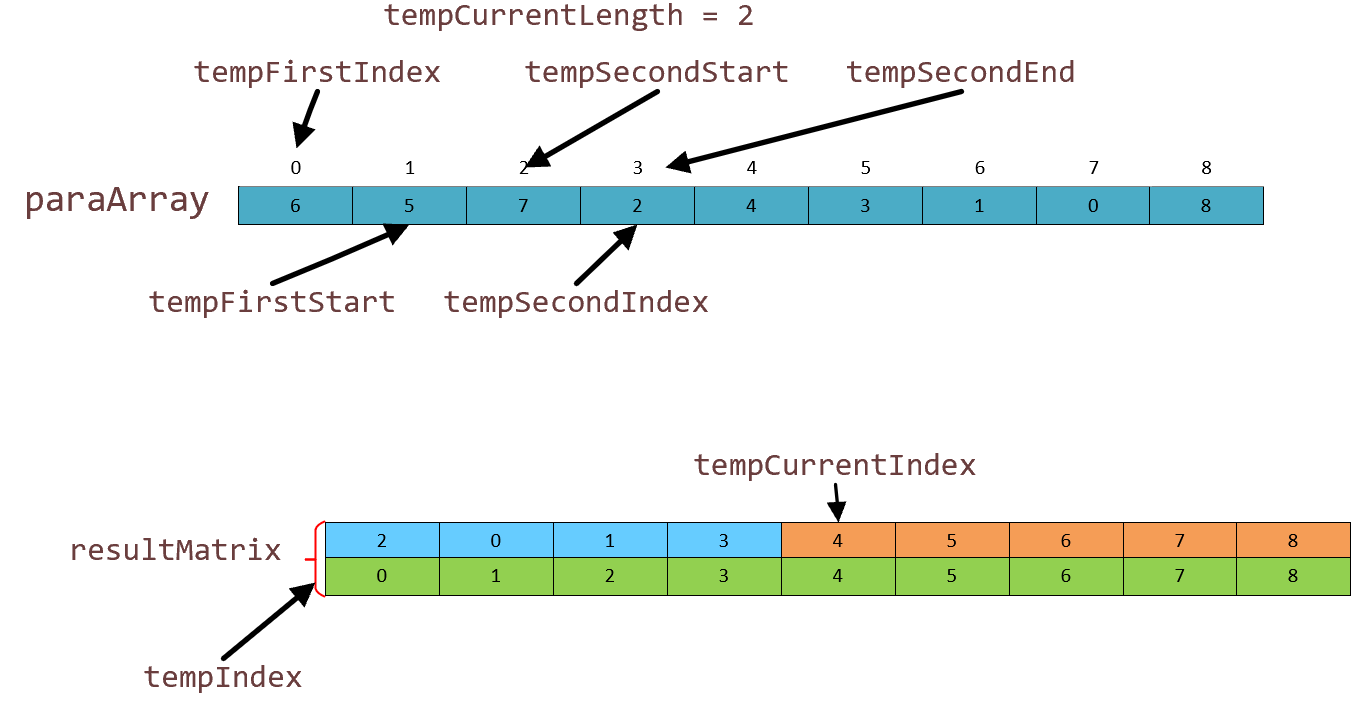 resultMatrix中蓝色的部分就是我们这一轮排好的索引。接下来我们对后面4个进行归并排序,操作流程一样我们不在描述了。然后只剩一个块,操作和 tempCurrentLength = 1,剩一个块的情况一模一样,不在赘述了,列出第二轮结果图(8 号元素没有轮到,其实最后一步也是直接复制进去):
resultMatrix中蓝色的部分就是我们这一轮排好的索引。接下来我们对后面4个进行归并排序,操作流程一样我们不在描述了。然后只剩一个块,操作和 tempCurrentLength = 1,剩一个块的情况一模一样,不在赘述了,列出第二轮结果图(8 号元素没有轮到,其实最后一步也是直接复制进去):

这时候 tempCurrentLength 变成 4 了,块的大小变成了 4。现在我们进行比较,你说会这不都一样吗?但是没有私货怎么敢写呢,这里主要给大家说说明明我们 tempArray 数组没有改变,改变的是储存数组,既然 tempArray 数组都没有改变,怎么叫排序呢,这不是胡扯嘛。听我细细说来:先交代一下,tempMatrix 储存结果换到了第二行。初始值指针如下
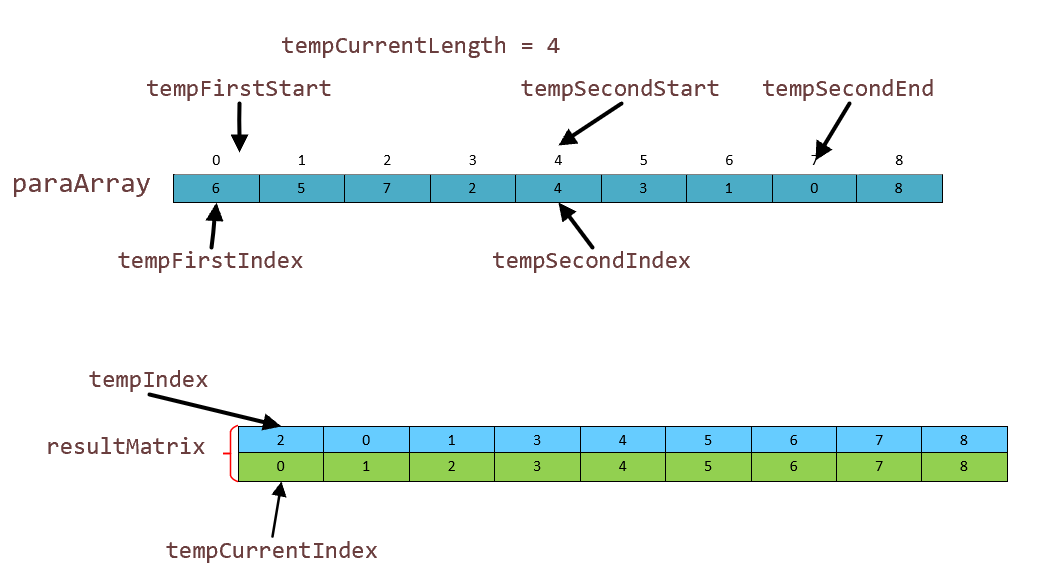
排序核心寻址
verygood,如果你现在比较的话是按照 tempArray 这个顺序的话,那你就等于没有排序,实际上是需要我们 resultMatrix 数组的第一行作为参考去寻址,第一个位置储存的不是6 ,而是 2 号位置的 7。也就是说我们把 tempMattrix 数组的蓝色空间储存的地址,按照 tempArray 数组还原成这样,对这个数组进行归并的。

注意第三个数组是虚拟的,我们便于直观画出来的 下面便是处理这中行为的代码:也就是比较部分
while ((tempFirstIndex <= tempSecondStart - 1)// 如果第一个块的位置,没有和第二个块开始的位置衔接,
&& (tempSecondIndex <= tempSecondEnd)) {
// 第二个块开始的位置没有和第二个块结束的位置衔接,那么执行迭代
if (paraArray[resultMatrix[tempIndex% 2][tempFirstIndex]] >= paraArray[resultMatrix[tempIndex% 2][tempSecondIndex]]) {
resultMatrix[(tempIndex + 1) % 2][tempCurrentIndex] = resultMatrix[tempIndex% 2][tempFirstIndex];
tempFirstIndex++;
} else {
resultMatrix[(tempIndex + 1) % 2][tempCurrentIndex] = resultMatrix[tempIndex% 2][tempSecondIndex];
tempSecondIndex++; // 比较数组指针移动
} // Of if
tempCurrentIndex++; // 索引数组指针移动
} // Of while
那么我就可以纠正一下 我上面的错误了,为了方便理解,我直接把tempFirst,等一系列指针画在了 tempArray 数组中,实际上它是在 tempMatrix 数组中进行卡范围,遍历游走,tempArray 数组只是作为一个映射标准,没有动用它。真实情况如图:

重复昨天的故事,知道排序完成。呀呼~,返回一个排序好的数组索引:8, 2, 0, 1, 4, 5, 3, 6, 7
小结:
- tempFirstStart,tempSecondStart,tempSecondEnd 用来卡主两个块的位置
- tempFirstIndex,tempSecondIndex负责在这两个块中遍历比较,实际最多只有两个块的比较大小排序
- tempCurrentLength 负责控制块的大小
- tempCurrentIndex 负责控制 tempMatrix 数组存储位置,元素放进来一个后移一位
- tempMatrix 数组是一个二维数组,我把空间分成: 排序参照地址区 和 存储结果区,上面 1,2两点索引都在 排序参照地址区。排序参照地址区 开始阶段是参考 tempArray 数组初始化地址,其后的更新都是每一轮 tempCurrentLength = n 局部排序完成的结果。
- tempIndex 是负责 排序参照区 和 存储结果区 互换的指针,我们把排好序的结果逐个放在排序参照区,那么正在使用的 排序参照区 将会慢慢变为 存储结果区,而排序完成后,这个 排序参照区 转化成了 存储结果区,下一轮开始又会成为下一轮的参照区。另外一个区对立转化
- 总的思路:一个地址映射数组 tempArray数组,地址索引数组 tempMatrix[][].归并排序是两个块开始为 1,同步移动的两个块,当块中的元素变多,当一个块完成比较,另外一个块的剩下序号有序可以直接复制进去。如果最后一个单着的元素,将会一直单着,知道最后一次归并纳入排序。
花了大量的时间来解释这个排序返回地址的方法,是因为这在机器学习的处理中很常用,要搞懂,当然你要用Python那就另当别论了哈哈哈。下面我们继续旅途,刚刚爬了一座山有没有累?出去走一下吧,后面的内容将会轻松许多。
descendantDensities = mergeSortToIndices(densities);
第266行,我们在这里获得了一个降序排列的索引密度数组,第 267 行就是把这个密度数组的最大密度设置成大哥。270~283就是在密度数组中来选取大哥,一定记得在比自己高的密度结点中选取距离近的哦。
这里就完成了优先级的排序,大哥的选择。下面我们将进入基于主动学习的聚类了,这里也是核心但是没有那么绕了,这个方法是重载的。
clusterBasedActiveLearning(descendantRepresentatives)
public void clusterBasedActiveLearning(int[] paraBlock) {
System.out.println("clusterBasedActiveLearning for block " + Arrays.toString(paraBlock));
// Step 1. 这个块可以查询的最大长度
int tempExpectedQueries = (int) Math.sqrt(paraBlock.length); // 这个块可以查询的最大长度
int tempNumQuery = 0;
for (int i = 0; i < paraBlock.length; i++) {
// 统计查询过的数量
if (instanceStatusArray[paraBlock[i]] == 1) {
tempNumQuery++;
} // Of if
} // Of for i
// Step 2. 如果我们的查询数量超过预期用完了,这个块的数目小于最小块我们进行投票。
if ((tempNumQuery >= tempExpectedQueries) && (paraBlock.length <= smallBlockThreshold)) {
System.out.println("" + tempNumQuery + " instances are queried, vote for block: \r\n"
+ Arrays.toString(paraBlock));
vote(paraBlock);
return;
} // Of if
// Step 3. Query enough labels.
for (int i = 0; i < tempExpectedQueries; i++) {
if (numQuery >= maxNumQuery) {
System.out.println("No more queries are provided, numQuery = " + numQuery + ".");
vote(paraBlock);
return;
} // Of if
if (instanceStatusArray[paraBlock[i]] == 0) {
instanceStatusArray[paraBlock[i]] = 1;
predictedLabels[paraBlock[i]] = (int) dataset.instance(paraBlock[i]).classValue();
// System.out.println("Query #" + paraBlock[i] + ", numQuery = "
// + numQuery);
numQuery++;
} // Of if
} // Of for i
// Step 4. Pure?
int tempFirstLabel = predictedLabels[paraBlock[0]];
boolean tempPure = true;
for (int i = 1; i < tempExpectedQueries; i++) {
if (predictedLabels[paraBlock[i]] != tempFirstLabel) {
tempPure = false;
break;
} // Of if
} // Of for i
if (tempPure) {
System.out.println("Classify for pure block: " + Arrays.toString(paraBlock));
for (int i = tempExpectedQueries; i < paraBlock.length; i++) {
if (instanceStatusArray[paraBlock[i]] == 0) {
predictedLabels[paraBlock[i]] = tempFirstLabel;
instanceStatusArray[paraBlock[i]] = 2;
} // Of if
} // Of for i
return;
} // Of if
// Step 5. Split in two and process them independently.
int[][] tempBlocks = clusterInTwo(paraBlock);
for (int i = 0; i < 2; i++) {
// Attention: recursive invoking here.
clusterBasedActiveLearning(tempBlocks[i]);
} // Of for i
}// Of clusterBasedActiveLearning
- 459 - 475 行设置这个块的最大查询数目,然后看看这个块已经查询了多少标签,查询数目上限,又是小块(小于一个块最小的域值)。我们进行投票判断这个块的种类。
- 478 - 492一个 for 循环去查询更多的标签,如果查询的数目已经大于了总的查询数目,我们进行投票决定这个块的类别。反之我们就会查询这个块的高密度实例。
- 495 - 502 行判断我们这个块是否为纯的:这个块的第一个实例密度最高,它的类本应该代表它后面的实例,因此我们把其后面查询的标签和老大比较,相同则纯,反之由杂。
- 503 - 520 行,如果块是纯的,那么我们就给这个块没有查询的实例贴上和老大一样的类 tempFirstlable ,查询状态值为2( 2 代表是学习器判断的标签,0 代表未知种类,1 代表向教授查询的标签)。如果不纯,那么我们继续分块咯,你不服从那就自立家门吧,重复以上操作。
vote()
public void vote(int[] paraBlock) {
int[] tempClassCounts = new int[dataset.numClasses()];
for (int i = 0; i < paraBlock.length; i++) {
if (instanceStatusArray[paraBlock[i]] == 1) {
tempClassCounts[(int) dataset.instance(paraBlock[i]).classValue()]++;
} // Of if
} // Of for i
int tempMaxClass = -1;
int tempMaxCount = -1;
for (int i = 0; i < tempClassCounts.length; i++) {
if (tempMaxCount < tempClassCounts[i]) {
tempMaxClass = i;
tempMaxCount = tempClassCounts[i];
} // Of if
} // Of for i
// Classify unprocessed instances.
for (int i = 0; i < paraBlock.length; i++) {
if (instanceStatusArray[paraBlock[i]] == 0) {
predictedLabels[paraBlock[i]] = tempMaxClass;
instanceStatusArray[paraBlock[i]] = 2;
} // Of if
} // Of for i
}// Of vote
这个投票方法就简单了,在此块中找出我们已经查询的最多的类标签,然后把这个块没有查询的标签也贴上这个类标签。把对应的状态设置为 2.
clusterInTwo(int[] paraBlock)
/**
*************************
*一个块中的结点应该和老大一样.这个递归方法是高效的
*
*
* @param paraIndex
* 结点索引
* @return 当前结点的簇索引。
*************************
*/
public int coincideWithMaster(int paraIndex) {
if (clusterIndices[paraIndex] == -1) {
int tempMaster = masters[paraIndex];// 找出这个结点的老大的索引
clusterIndices[paraIndex] = coincideWithMaster(tempMaster);// 老大到追溯到顶
} // Of if
return clusterIndices[paraIndex]; // 返回这个实例的老大。
}// Of coincideWithMaster
/**
*************************
* 根据大佬,把这个块分成两个。
*
* @param paraBlock
* The given block.
* @return The new blocks where the two most represent instances serve as
* the root.
*************************
*/
public int[][] clusterInTwo(int[] paraBlock) {
// 初始化
// 聚类
Arrays.fill(clusterIndices, -1);// 开始这个块是空的
// 把这个块分成两个,前两个实例是密度最高的实例,最能成为子块的代表
for (int i = 0; i < 2; i++) {
clusterIndices[paraBlock[i]] = i;
} // Of for i // 两个子块成为老大,旗号 0 ,1
for (int i = 0; i < paraBlock.length; i++) {
if (clusterIndices[paraBlock[i]] != -1) {
// 已经有所属关系了
continue;
} // Of if
clusterIndices[paraBlock[i]] = coincideWithMaster(masters[paraBlock[i]]);
} // Of for i
// 子块
int[][] resultBlocks = new int[2][];
int tempFistBlockCount = 0;
for (int i = 0; i < clusterIndices.length; i++) {
if (clusterIndices[i] == 0) {
tempFistBlockCount++;
} // Of if
} // Of for i
resultBlocks[0] = new int[tempFistBlockCount];// 第一个子块
resultBlocks[1] = new int[paraBlock.length - tempFistBlockCount];// 第二个子块
// 把这个块的数据分配到两个子块中去。
//
int tempFirstIndex = 0;
int tempSecondIndex = 0;
for (int i = 0; i < paraBlock.length; i++) {
if (clusterIndices[paraBlock[i]] == 0) {
resultBlocks[0][tempFirstIndex] = paraBlock[i];
tempFirstIndex++;
} else {
resultBlocks[1][tempSecondIndex] = paraBlock[i];
tempSecondIndex++;
} // Of if
} // Of for i
System.out.println("Split (" + paraBlock.length + ") instances "
+ Arrays.toString(paraBlock) + "\r\nto (" + resultBlocks[0].length + ") instances "
+ Arrays.toString(resultBlocks[0]) + "\r\nand (" + resultBlocks[1].length
+ ") instances " + Arrays.toString(resultBlocks[1]));
return resultBlocks;
}// Of clusterInTwo
这两个方法是配套的,就是把不纯的子块进行分类。步骤是这样的
- 把分簇的存储索引置为-1,然后选择我们块中最大的两个密度实例,0,1是他们自己的编号也是他们的旗号。此时的 clusterIndices[]前两个位置已经有值 0,1.
- 338 - 345 行去遍历整个块(paraBlook),对应的clusterIndices[]数组元素没有老大,那就通过coincideWithMaster()方法去找,找到了就把老大存储在 clusterIndices[ ] 中。比如,8号实例的老大为 2,则 clusterIndices[ 8 ] = 2.
- 309 - 316 中的 coincideWithMaster() 方法,我们要分成两块,那么实例就要去找自己所属的阵营 0 还是 1,开始自己是空的 -1,通过递归往上找,最终总会知道自己要么是 0,要么是 1 阵营的。
- 当paraBlook中的实例都知道了自己的阵营,355 - 370 去把混合在一起的人分开,用一个二维数组存放。
运行完代码回到了 518 行,对新的阵营(块)进行检查,纯洁?不纯洁分阵营?还是不纯洁人少分不了阵营需要采取以少数服从多数原则进行投票?
就这样重复下去,分阵营,贴标签。最后完成 clusterBasedActiveLearning() 方法,实例分类完毕。ALEC方法结束,到站下车。
总结
- 本次讲解主要通过调试顺序,代码跨度较大。需要读者一起进入旅行,光看的话很难看懂。
- 目录已经列出了主要的方法,第一个难点是从概念映射到代码上,方法流程要熟悉。第二个难点便是寻址,我也不怕说,这个寻址画图花了 4 个小时,变量多,弄清楚会开心到起飞。
- 此处代码是我参考老师的代码,学习概念后自己做出的讲解,有误请留言改正。
- 我的缺点,不会时间复杂度分析的统计图,这个问题我就很羡慕别人会啊。这周开始搞,下周出成果。